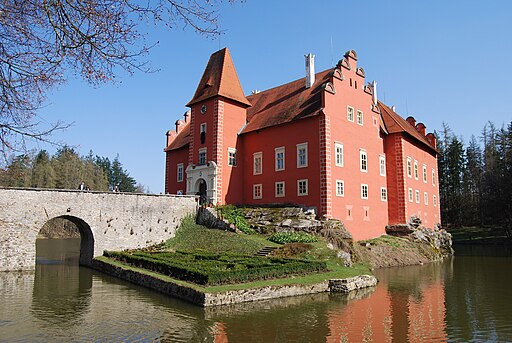Castle Červená Lhota
Temporarily owned by Ignaz and Moritz von Stillfried
The first written mention dates back to 1465. Jan Kába z Rybňan acquired the Gothic fortress of Nová Lhota in 1530 and rebuilt it into a chateau. In 1597, Wilhelm Ruth of Dírná acquired Nová Lhota, Nový Dvor and the houses below Jižná and Deštná, as well as the church of St. Trinity, and made it the dominion of Nové Lhoty Červené. Trinity and established the dominion of Nové Lhoty Červené, which also included the small towns of Deštná and the villages of Dírná, Březina and Višňová. Barbara Ruth sold Dírná to Adam Wratislaw of Mitrowitz in 1607.
Source/authorship: Richenza, CC BY-SA 3.0 <https://creativecommons.org/licenses/by-sa/3.0>, via Wikimedia Commons
After the Battle of the White Mountain, the Protestant Ruth of Dírná lost their property and the imperial army commander Balthasar de Maradas received Červená Lhota. Maradas sold the dominion to the imperial cavalry captain and garrison commander of Neuhaus, Antonio de Bruccio, who died in 1638.
After his death, Lhota became the property of the Slavata, the lords of Jindřichův Hradec. After the death of Ferdinand Wilhelm Slawata, the lineage became extinct in 1693. His daughter Maria Theresa sold the dominion to Ernst Friedrich Graf zu Windisch-Graetz. In 1755 Franz de Paula, Baron de Gudenus acquired Červená Lhota. In 1796, the Silesian nobleman Freiherr Ignaz von Stillfried bought the manor of Červená Lhota as well as the estates of Chválkov and Hojovice. From 1796 Stillfried invited the penniless and seriously ill Austrian composer Carl Ditters von Dittersdorf to stay with him, who spent the last years of his life in the Neuhof belonging to the castle.
In 1807, Freiherr Moritz von Stillfried (brother from Ignaz) inherited the estate. He sold the estate in 1820 to Theresia Veith, née Neupauer. In 1835, Heinrich Eduard Prince von Schönburg-Hartenstein (1787-1872) acquired Červená Lhota. At first, the new owners rebuilt the chateau. In the middle of the 19th century, a castle tower was erected and the gables were modified to adapt them to the neo-Gothic style common at the time. Between 1903 and 1913, these alterations were removed under Johann Schönburg-Hartenstein. He had the castle rebuilt in the neo-Renaissance style. The architect Humbert Walcher von Moltheim, a son of Leopold Walcher von Molthein, who gave the castle its present form, was in charge of this.




